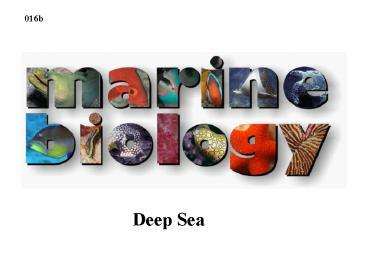Deep Sea - PowerPoint PPT Presentation
1 / 26
Title:
Deep Sea
Description:
100m dysphotic aphotic photic Deep Ocean Characteristics Cold Still Stable Dark Essentially no productivity Sparse Life Extremely high pressure Little food Deep sea ... – PowerPoint PPT presentation
Number of Views:286
Avg rating:3.0/5.0
Title: Deep Sea
1
016b
Deep Sea
2
Deep Sea
3
Ocean Zones
photic
100m
dysphotic
aphotic
4
Deep Ocean Characteristics
- Cold
- Still
- Stable
- Dark
- Essentially no productivity
- Sparse Life
- Extremely high pressure
- Little food
5
Potential Food Source for Deep Sea Organisms
Deep sea orgs are dependant upon surface
production from
- Dead phytoplankton, zooplankton, fish, mammals
- Fecal pellets and crustacean molts
- Macrophyte detritus
- Animal migrations
6
Potential food source for deep sea organisms
7
Whale Fall i.e., marine snow
Scavengers can feed on carcass in less than 6
months
8
Factors affecting organic material reaching the
sea floor
- Storms
- Seasonal variation
9
Hydrothermal Vents
10
Ocean Zones
photic
100m
dysphotic
aphotic
11
Mapping Hydrothermal Vents
12
Hydrothermal Vents
- Ballard Grassle (1977)- Alvin to Galapagos
- Sulfur-rich vents 660 oF, but quickly cool to 73
oF - Thermophilic bacteria associated with vent
communities
13
Location of Vents
Hydrothermal vents found at mid-ocean ridge
spreading centers.
14
Active hydrothermal vents were first discovered
at Loihi in the late 1980's
15
- 15 mi S.E. of Kilauea
- 3,178 ft below sea level
- Will reach sea level in 10,000 yrs
Loihi
16
(No Transcript)
17
Loihi
18
Formation of Vents
- Cold seawater sinks into cracks deep into ocean
floor - Water heated by magma rises and leaches out
minerals from surrounding rocks - The water emerges from vents and precipitates out
minerals
19
(No Transcript)
20
Alvin
21
Alvin with Temperature Probe
22
Hydrothermal Vent Communities
Tube worms- pogonophorans
- Other orgs
- Calyptogena- large white clam
- Large crabs
- Sea anemones
- Shrimp
23
Hydrothermal Vent Communities
- Support communities with high biomass, but low
diversity - Primary producers are chemosynthetic bacteria
- 90 endemism
- Communities are small (25-60m in diameter)
24
Chemosynthetic Bacteria
Chemosynthesis Oxygen hydrogen sulfide water
carbon dioxide sugar sulfuric acid 602
6H2S 6H20 6C02 C6H12O6 6H2S04
25
Photosynthesis vs Chemosynthesis
Photosynthesis 6H2O 6CO2 nutrients light
energy C6H12O6 6O2 Chemosynthesis 602
6H2S 6H20 6C02 C6H12O6 6H2S04
26
- Where are hydrothermal vents located?
- How do they form?
- Why doesnt the vent water boil?
- Describe the chemosynthetic bacteria's
relationship with the vent and other animals
living near the vent.































